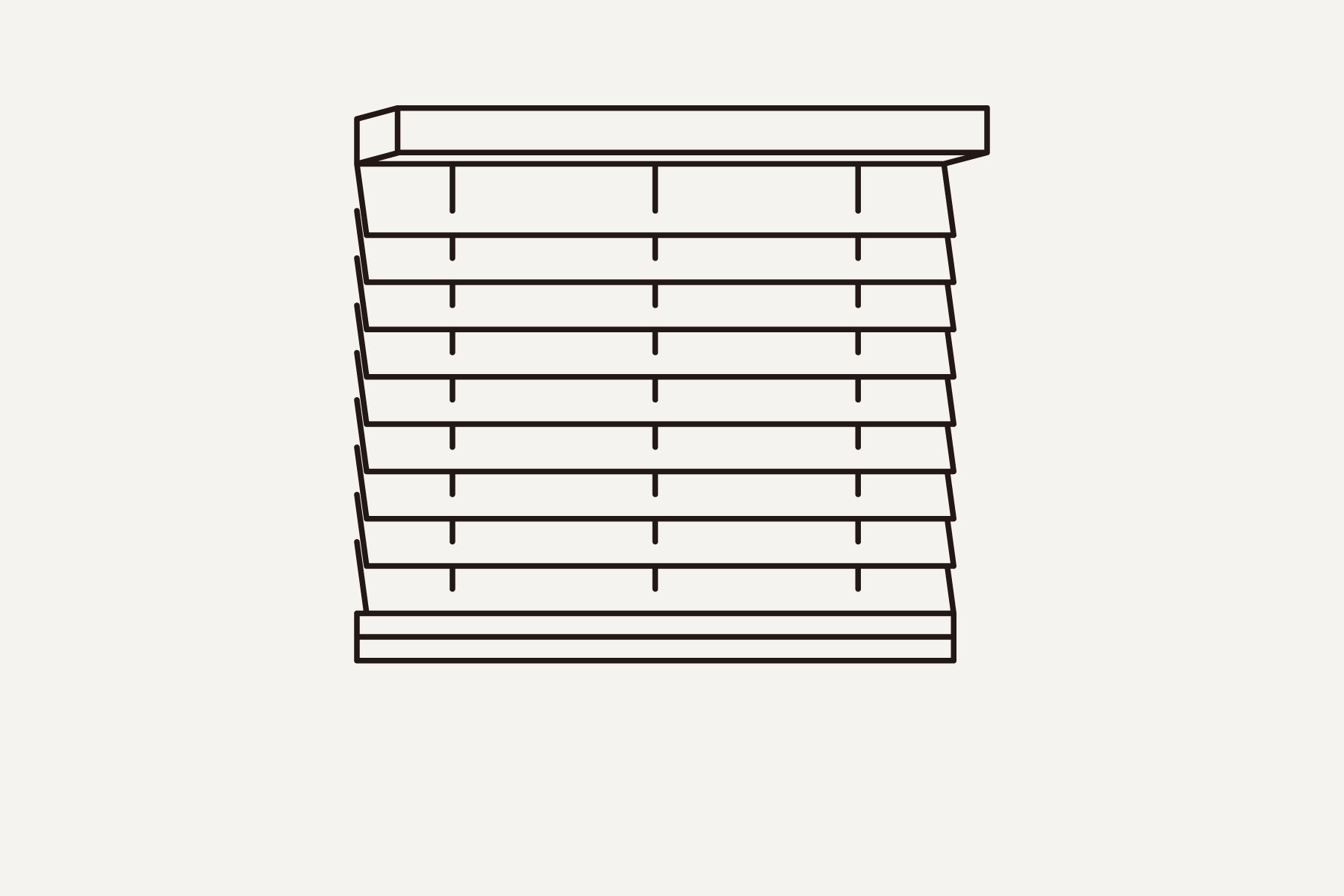What are Venetian Blinds
Venetian blinds are a type of window covering made from horizontal slats, usually made of wood, metal, or plastic, which can be adjusted to control the amount of light entering a room. These window blinds are operated using a variety of mechanisms, including cords, wands, or even motorized systems for added convenience. Available in numerous styles, colors, and finishes, Venetian blinds not only serve a practical purpose but also enhance the aesthetic appeal of any interior space. To better understand how Venetian blinds work, let’s take cordless wood blinds as an example. These blinds consist of several key components:
- Headrail: The headrail is the top part of the blind, housing the operating mechanism that controls the movement of the slats.
- Mounting Brackets: Mounting brackets are the hardware used to securely attach the blinds to the window frame. These brackets ensure that the window blinds stay in place and can be easily raised or lowered.
- Wand: The wand is used to tilt the slats to your desired angle. It provides a simple, hands-on way to control light and privacy without the need for cords. In some models, the wand may be motorized for added convenience.
- Slats: The slats are the individual strips of material (wood, metal, or plastic) that make up the body of the blinds. These can be adjusted to control the amount of light coming into the room, and they can be fully closed for maximum privacy or light-blocking.
- Lift Strings: Lift strings are cords or strings that run through the slats and allow you to raise or lower the entire blind.
- Ladder Strings: Ladder strings are the vertical cords that hold the slats and help maintain their position. These strings ensure that the slats remain evenly spaced, allowing for smooth and consistent movement when adjusting the blinds.
- Bottom Rail: The bottom rail is the horizontal bar at the bottom of the blinds, helping to keep the slats evenly aligned and adding weight to ensure the blinds hang straight. It also provides a sturdy grip for pulling the blinds up or down.

How are Venetian Blinds Made
Venetian blinds are a ubiquitous element in modern interior design, blending functionality with aesthetics. They provide privacy, control light, and enhance the ambiance of a room. While their presence is often taken for granted, the process of making window blinds is a fascinating journey through precision engineering and meticulous craftsmanship. This section delves into two critical components of these window blinds: the rails (both headrail and bottom rail) and the slats, exploring how each is crafted to create the perfect window covering.
Rails

Rails include the headrail and the bottom rail. The headrail, located at the top, houses the control mechanisms, while the bottom rail provides weight and a finished look at the bottom of the blinds. These rails must be crafted to precise specifications to ensure smooth operation, structural integrity, and an attractive appearance. Depending on the material used, the manufacturing process can vary significantly. Below is a breakdown of the different materials commonly used for blinds rails and the specific manufacturing processes for each.
1. Aluminum Rails
Aluminum is one of the most popular materials for window blinds, particularly for headrails, due to its strength, lightweight nature, and corrosion resistance.
- Material Preparation: The process starts with aluminum billets (solid metal pieces) that are heated to soften the metal, making it easier to shape.
- Extrusion Process: The heated aluminum is pushed through a mold (die) to form long sections with the desired profile. This process allows for consistent shapes that can be cut to different lengths.
- Cutting and Shaping: After extrusion, the aluminum is cut to the required lengths for the headrail and bottom rail components. The ends are then shaped to accommodate mounting brackets and end caps.
- Punching and Drilling: Holes are punched or drilled into the rail for the mounting hardware, lift mechanisms, and any internal components like the tilt mechanism or cord locks.
- Finishing: The extruded aluminum is typically anodized or powder-coated to provide a durable finish. Anodizing helps improve the aluminum’s corrosion resistance, while powder coating allows for a range of colors and textures, making the rails aesthetically versatile.
- Assembly: The various internal components like tilt rods, cord locks, or motorized parts (in case of motorized blinds) are assembled into the headrail. End caps are also attached to the rail.
2. Steel Rails
Steel rails are often used in high-strength applications, particularly for larger or heavier blinds, and provide exceptional durability.
- Material Preparation: Steel rails are often made from cold-rolled steel strips or sheets. These materials are pre-processed to enhance strength and ductility before they are shaped.
- Roll Forming: Instead of extrusion, steel rails are typically made using roll forming. In this process, flat steel strips are passed through a series of rollers that bend and shape the metal into the desired rail profile. This technique allows for continuous production of uniform shapes.
- Cutting to Length: After roll forming, the steel is cut into the appropriate lengths for the headrail and bottom rail.
- Punching and Notching: Holes and notches are punched into the steel to accommodate the lift system, cord locks, and mounting brackets.
- Surface Treatment: To prevent rust and corrosion, steel rails are often galvanized, powder-coated, or painted. The powder-coating process provides a more durable, smooth finish, which can also add color to match design preferences.
- Assembly: The rails are then assembled with all necessary internal mechanisms, such as tilt rods or chains, depending on the style of blinds.
Slats

Slats are the horizontal elements that block or filter light and are pivotal to the functionality and appearance of the blinds. Slats can be made from various materials, including wood, faux wood, aluminum, vinyl, and fabric.
- Wooden Slats: Often crafted from basswood or other lightweight, durable woods. The wood is kiln-dried to reduce moisture content, preventing warping and increasing longevity.
- Faux Wood Slats: Made from PVC or composite materials, faux wood slats offer the look of real wood with added moisture resistance, making them ideal for humid environments.
- Aluminum Slats: Lightweight and durable, aluminum slats are often chosen for their sleek, modern appearance and ease of maintenance.
- Vinyl and Fabric Slats: Vinyl slats are budget-friendly and moisture-resistant, while fabric slats add a soft, decorative element to the blinds.
After material preparation, slats will undergo the following manufacturing process:
- Cutting and Shaping: The chosen material is cut into thin strips of precise width and length. This requires high precision machinery to ensure uniformity.
- Finishing: Slats undergo various finishing processes depending on the material. Wooden slats are sanded and stained or painted, aluminum slats are anodized or powder-coated, and vinyl slats are molded and sometimes printed with patterns.
- Perforation and Notching: Holes for lift cords and notches for tilt mechanisms are punched into the slats. This step is crucial for the functionality of the blinds, ensuring smooth operation and even spacing.
- Assembly: Finally, the slats are threaded onto the lift cords and attached to the headrail and bottom rail.
How Do Cordless Venetian Blinds Work
Cordless Venetian blinds can be categorized into two main types: manual and motorized. Each type employs different mechanisms to operate without the need for traditional cords. This section explores how both manual and motorized cordless window blinds work.
Manual Window Blinds

Manual cordless window blinds are a type of window covering that can be adjusted manually without the use of cords or chains. At the heart of most manual cordless blinds is a sophisticated spring-loaded mechanism. This design allows for effortless operation while maintaining a sleek appearance. Here’s a detailed explanation of how this mechanism works:
- Raising the Blinds:
1.When the user pushes the bottom rail of the blinds upward, this action pulls on the attached rope or strap, which is connected to the spring inside the headrail.
2.As the bottom rail is pushed up, it causes the spring to compress, storing potential energy. The tension in the spring increases as it is compressed further.
3.Once the bottom rail reaches the desired height, the user releases it. At this point, the locking mechanism engages, holding the blinds securely in position. The energy stored in the compressed spring helps keep the blinds lifted until the user decides to lower them. - Lowering the Blinds:
1.To lower the blinds, the user gently pulls down on the bottom rail. This action releases the lock on the mechanism.
2.As the lock disengages, the stored energy in the spring is released, allowing the blinds to descend smoothly. The spring’s tension assists in controlling the descent, ensuring that the blinds move down gradually and evenly.
3.The user can control the speed and height of the descent by adjusting the pressure applied to the bottom rail.
Motorized Window Blinds

Motorized window blinds are window coverings that can be adjusted automatically using an electric motor, typically controlled by a remote, smartphone app, or home automation system. These blinds take the convenience of cordless operation a step further. Here’s how they function:
- Electric Motor: At the heart of motorized blinds is a small tubular motor that drives the opening and closing mechanisms. This motor is typically housed within the headrail of the blinds. When activated, the motor adjusts the position of the blinds seamlessly.
- Control Options: Users can control motorized blinds through various methods:
1.Remote Control: Many systems come with handheld remotes that allow users to operate multiple blinds simultaneously or individually.
2.Smart Home Integration: Many modern motorized blinds can connect to smart home systems, allowing for voice-activated control via smart assistants like Amazon Alexa or Google Assistant.
3.Mobile Apps: Some motorized blinds can be controlled through dedicated mobile applications, providing users with the ability to set schedules, adjust settings, and manage multiple window treatments from their smartphones. - Battery or Hardwired Options: Motorized window blinds are available in battery-operated models, which are easy to install and require minimal maintenance. Alternatively, hardwired options can be connected directly to the home’s electrical system, providing a permanent solution without the need for battery replacements.
Features and Functions of Venetian Blinds
Venetian blinds come in a variety of styles, materials, and designs, each offering unique benefits. Understanding the key features and functions of window blinds can help homeowners make informed decisions that suit their needs. This section explores four critical aspects: light control, waterproofing, UV protection, and ventilation.
Light Control
One of the primary functions of Venetian blinds is their ability to control the amount of light entering a room. This feature is essential for creating a comfortable living environment, allowing homeowners to tailor the ambiance of their spaces according to their needs. By adjusting the tilt of the slats, you can precisely regulate the amount of sunlight filtering into the room, which can help reduce glare on screens, protect furniture and flooring from UV damage, and maintain an optimal temperature indoors.
Waterproof
Waterproofing is an essential feature for Venetian blinds, particularly in areas prone to moisture, such as kitchens, bathrooms, and laundry rooms. The right blinds can withstand humidity and resist damage. Blinds made from materials like faux wood and aluminum are often designed to be waterproof. Faux wood blinds, in particular, offer the classic look of real wood without the risk of warping or cracking in humid conditions. Aluminum blinds are also moisture-resistant and can be easily wiped clean, making them ideal for high-humidity environments. Unlike traditional fabric blinds, these materials maintain their appearance and functionality over time.
Waterproof blinds are not only practical but also promote hygiene. They can be easily cleaned with soap and water, helping to prevent the growth of mold and mildew, which is especially important in homes with children or pets. This ease of maintenance ensures a healthy living space that remains fresh and inviting.
UV Protection
Ultraviolet (UV) rays from the sun can cause significant damage to interior furnishings, flooring, and artwork, leading to fading and deterioration over time. Venetian blinds can effectively protect against harmful UV radiation. Many types of blinds, including faux wood, wood, and aluminum blinds, are designed to provide UV protection. By utilizing these blinds, homeowners can shield their furniture, carpets, and artwork from sun damage, thereby extending their lifespan. This protective feature is essential for maintaining the beauty and durability of interior spaces.
In addition to safeguarding interiors, UV protection contributes to energy efficiency. Blinds that block harmful rays while allowing natural light to filter through help maintain a comfortable indoor temperature, reducing the need for heating and cooling systems. This can lead to lower energy bills and a reduced carbon footprint, making them an eco-friendly choice for homeowners.
Ventilation
While Venetian blinds are primarily used for light control and privacy, they also facilitate ventilation. The ability to manage airflow in a space can significantly enhance comfort levels, especially during warmer months. Blinds with adjustable slats allow homeowners to control airflow effectively. By tilting or drawing the slats, users can direct fresh air into the room. This feature is particularly beneficial in areas where cross-ventilation is desired, enabling homeowners to enjoy a cool breeze.
Choosing the right window blinds for your home can transform your space, providing not only aesthetic appeal but also functional benefits such as light control, privacy, and energy efficiency. By understanding the various types of blinds available, their materials, and the specific needs of each room, you can make an informed decision that enhances your living environment. As you embark on your journey to find the perfect window treatments, let Hestia Blinds be your trusted partner. With a wide selection of high-quality blinds and expert advice, Hestia Blinds can help you achieve the ideal look and functionality for your home.



Share:
The Complete Guide to Roller Shades
Roller Shades Fabric Series ① : Poly-Linen Blends